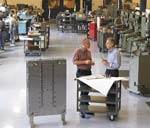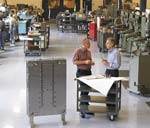How to Justify Your Hot Runner Purchase
Four questions to help with hot runner justification.
One of the first questions we ask customers is do they really need a hot runner system. Simply making the decision to go 100 percent hot runner very rarely makes sense economically or practically. Hot runners add additional complexity to the molding process that needs to be considered. The justification for the use of a hot runner needs to be based on solid information and several questions need to be asked:
1. Will there be a cost savings based on not generating wasted regrind?
This is the most basic item usually focused on. If the parts to be molded only allow 20 percent regrind, can the parts be molded with a cold runner system and have the runner weight be within that 20 percent? If not, can the extra material be used on another application? For instance, many medical molders using cold runners that need to run with 100 percent virgin material use their regrind to mold less critical parts. A typical example might be the use of virgin material on medical test tubes and use the regrind to produce the racks to hold them.
In some states certain fillers in the resins disallow them from being deposited in the landfill. This often results in the material being stored wasting valuable floor space. While selling the reground runners is always an option, the prices paid for it usually amount to pennies on the dollar.
2. Will there be a reduction in cycle time?
Will the fact that there will not be a cold runner reduce the cycle time? Typically in a cold runner mold the cold runner combination has a cross-section of up to several times the part wall thickness. Because the runner is thicker, it takes longer to cool than the part being molded. This results in increased mold-closed time to cool the runner to the point that it can be ejected. It is not unusual to have the mold-closed time double for the runner to be cooled to the point it can be ejected.
Since hot runner molds do not have a runner to cool, the mold-closed time can be reduced to the actual time required for the part being molded to cool.
3. Will a hot runner system increase the uptime of the mold?
Often when gating parts with a cold runner system, it is necessary to gate on the top of the part versus the side. A three-plate configuration is typically used to get the material to the part to be molded. The three-plate portion of a mold is notorious for causing problems—such as having the runner not falling correctly and having it get caught in the mold during clamping sequence; having the bolts that pull the stripper plate forward break; or, having to constantly readjust the friction pullers if they are used.
Hot runner molds generally have no moving parts or mechanisms (with the exception of valve gate hot runner systems), which results in less downtime. Hot runners do have heaters and thermocouples that need to be replaced from time to time, but compared to a three-plate mechanism the downtime is insignificant. These components are often replaced on scheduled cycles for general mold maintenance.
4. Will it result in decreased man-hours?
Choosing a hot runner system versus a cold runner system has obvious man-hour benefits. The elimination of sorting runners from the parts, the ability to use automated equipment to box and bag parts directly at the molding machine, and eliminating handling of the parts reduces the chance for the finished parts to be contaminated.
Sorting It All Out
The basic calculations used to determine the potential savings in using a hot runner system versus a cold runner system can be done by hand. There also are several sources available on the Internet with hot runner calculators to aid in determining the hot runner payback—analyze the costs for using a cold sprue bushing versus a heated sprue bushing and a cold runner system versus a manifold system.
General information—such as cold runner weight, material cost, cycle time, machine usage and estimated hot runner cost—is entered into the fields and the program then calculates the results. It is easy to make changes to the fields to run several scenarios varying the cycle times and number of cavities to determine the best results.
While the use of a hot runner system is often an excellent option, answering some basic questions and using the tools available on the Internet aid in making an intelligent decision.
Related Content
The Ins and Outs of Hot Runner Temperature Control
A training checklist that explains the why and how of proper hot runner temperature control and system management.
Read MoreThe Benefits of Hand Scraping
Accuracy and flatness are two benefits of hand scraping that help improve machine loop stiffness, workpiece surface finish and component geometry.
Read MoreHow to Eliminate Chatter
Here are techniques commonly used to combat chatter and guidelines to establish a foundation for optimizing the moldmaking process.
Read MoreLine Width vs. Depth Ratio in Laser Engraving
A laser does not produce 90-degree sidewalls. It requires a certain amount of draft in order to produce the required pattern.
Read MoreRead Next
Maintaining a Strong Relationship with Your Hot Runner Supplier
Once your hot runner supplier is chosen, you need to take the proper steps to maintain a mutually beneficial, long-term relationship.
Read MoreHow to Use Strategic Planning Tools, Data to Manage the Human Side of Business
Q&A with Marion Wells, MMT EAB member and founder of Human Asset Management.
Read MoreHow to Use Continuing Education to Remain Competitive in Moldmaking
Continued training helps moldmakers make tooling decisions and properly use the latest cutting tool to efficiently machine high-quality molds.
Read More




















